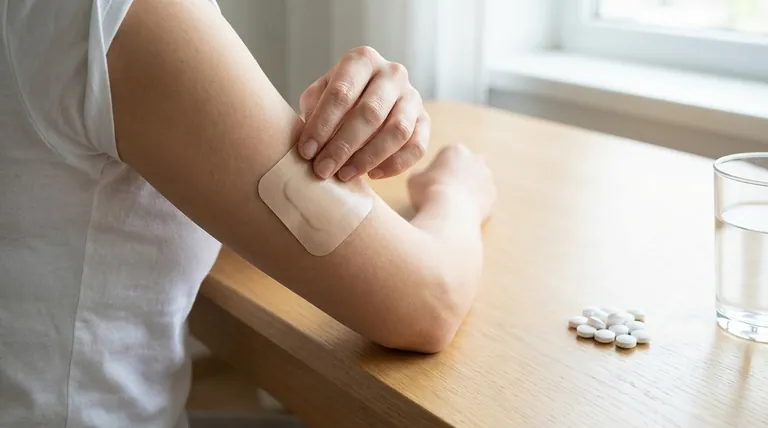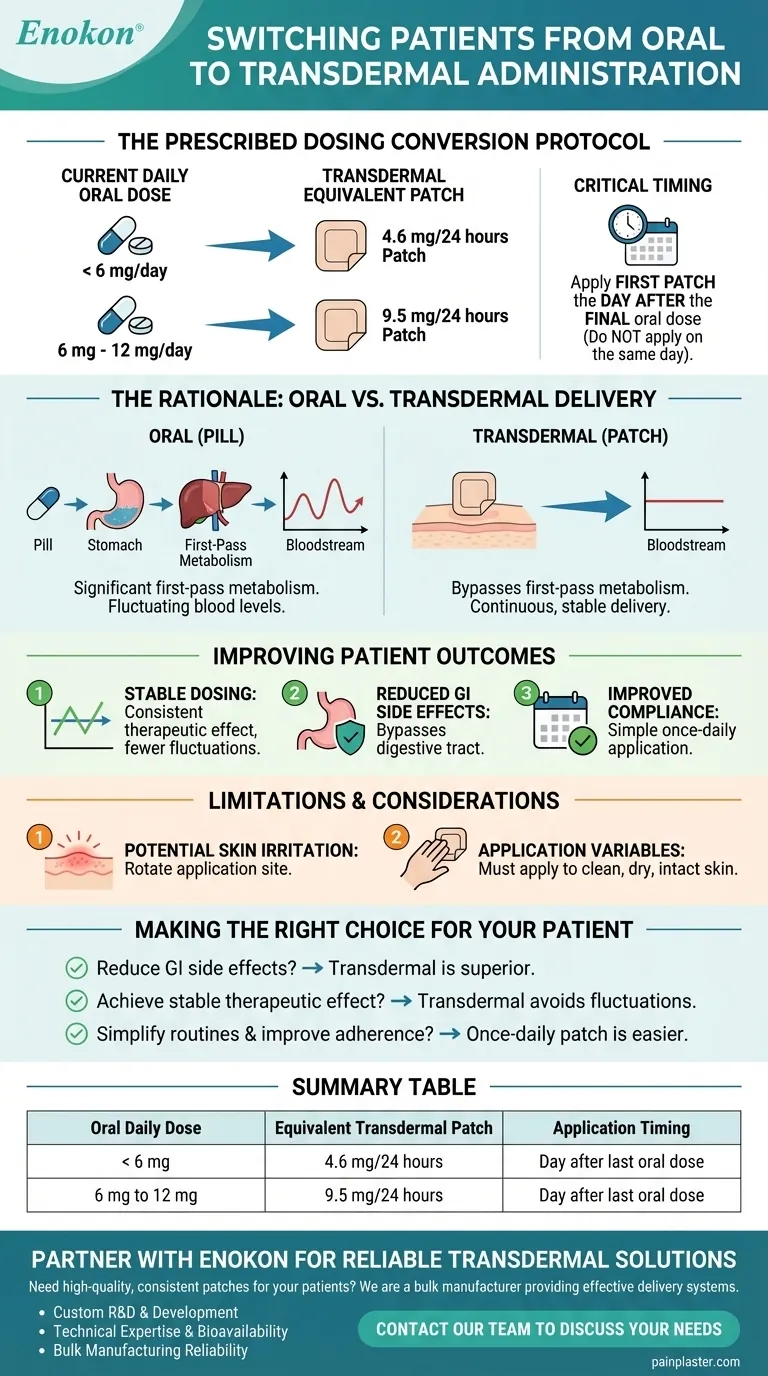To properly switch a patient from oral to transdermal administration, the conversion depends directly on their current daily oral dose. For patients on less than 6 mg per day, the correct transdermal equivalent is the 4.6 mg/24 hours patch. For those on a daily oral dose between 6 mg and 12 mg, the appropriate choice is the 9.5 mg/24 hours patch. The new patch should be applied on the day immediately following the patient's last oral dose.
Switching from an oral medication to a transdermal patch is not a simple dose-for-dose equivalent. The conversion accounts for fundamental differences in how the body absorbs the drug, with the patch bypassing the digestive system to provide a more direct and stable delivery into the bloodstream.

The Rationale: Oral vs. Transdermal Delivery
Understanding why a specific conversion protocol is necessary requires looking at how each delivery method works within the body. The two routes are pharmacologically distinct, leading to different patient outcomes.
Bypassing First-Pass Metabolism
When a drug is taken orally, it is absorbed through the gastrointestinal (GI) tract and travels first to the liver. The liver metabolizes a significant portion of the drug before it ever reaches systemic circulation, a process known as first-pass metabolism.
This means a higher oral dose is required to achieve the desired therapeutic effect. Transdermal patches bypass this entire process, delivering the medication directly into the bloodstream through the skin.
Ensuring Continuous and Stable Dosing
Oral medications create peaks and troughs in the drug's concentration in the blood, corresponding to when a dose is taken.
A transdermal patch, by contrast, provides continuous, stable administration over a 24-hour period. This avoids fluctuations, potentially leading to a more consistent therapeutic effect and fewer side effects.
Improving the Patient Experience
The transdermal route avoids the GI tract entirely, which can reduce the risk of gastrointestinal side effects like nausea or stomach upset.
For many patients, especially those with cognitive impairments or complex medication schedules, applying a single daily patch can significantly improve compliance compared to remembering multiple oral doses.
The Prescribed Dosing Conversion Protocol
The conversion is based on established clinical guidelines to ensure a safe and effective transition.
For Daily Oral Doses Under 6 mg
The patient should be switched directly to the 4.6 mg/24 hours transdermal patch. This is considered the appropriate starting dose for patients on lower oral regimens.
For Daily Oral Doses of 6 mg to 12 mg
Patients in this dosage range should be switched to the 9.5 mg/24 hours transdermal patch. This dose is designed to provide a comparable therapeutic blood level for those on a moderate oral dose.
Critical Timing: The Day-After Application
To prevent a potential overdose from overlapping drug effects, the first patch must be applied the day after the final oral dose was taken. Do not apply the first patch on the same day as the last pill.
Understanding the Trade-offs
While the transdermal route offers clear advantages, it is essential to be aware of its specific limitations and considerations.
Potential for Skin Irritation
The most common side effect of transdermal patches is local skin reaction at the application site. This can include redness, itching, or irritation. Rotating the application site is critical to minimize this risk.
Adhesion and Application Variables
Proper application is key to effectiveness. The patch must be applied to clean, dry, and intact skin. Factors like excessive sweating, lotions, or improper placement can interfere with adhesion and reduce drug delivery.
Making the Right Choice for Your Patient
The decision to switch from oral to transdermal delivery should be guided by specific therapeutic goals and patient characteristics.
- If your primary focus is reducing gastrointestinal side effects: The transdermal patch is the superior option as it completely bypasses the digestive system.
- If your primary focus is achieving the most stable therapeutic effect: The continuous delivery of the patch avoids the blood-level fluctuations inherent with oral dosing.
- If your primary focus is improving patient adherence and simplifying routines: A once-daily patch is often easier for patients and caregivers to manage than multiple daily pills.
By following this precise conversion protocol, you can effectively transition a patient to leverage the benefits of transdermal drug delivery.
Summary Table:
| Oral Daily Dose | Equivalent Transdermal Patch | Application Timing |
|---|---|---|
| Less than 6 mg | 4.6 mg/24 hours | Day after last oral dose |
| 6 mg to 12 mg | 9.5 mg/24 hours | Day after last oral dose |
Need reliable transdermal patches for your patients?
Switching from oral to transdermal administration requires precision and high-quality products. As Enokon, a bulk manufacturer of reliable transdermal patches and pain plasters, we provide healthcare and pharma distributors and brands with the consistent, effective delivery systems essential for successful patient transitions.
Partner with us to benefit from:
- Custom R&D and Development: Tailor patches to your specific drug formulation and release profile.
- Technical Expertise: Leverage our deep knowledge of transdermal technology to ensure optimal bioavailability and patient compliance.
- Bulk Manufacturing Reliability: Scale your supply with confidence using our high-quality, consistent production.
Enhance your treatment options with advanced transdermal solutions. Contact our team today to discuss your needs.
Visual Guide

Related Products
- Far Infrared Heat Pain Relief Patches Transdermal Patches
- Capsaicin Chili Medicated Pain Relief Patches
- Herbal Eye Protection Patch Eye Patch
- Heating Pain Relief Patches for Menstrual Cramps
- Menthol Gel Pain Relief Patch
People Also Ask
- How does the Deep Heat Back Patch work? A Drug-Free Solution for Targeted Pain Relief
- Are heat patches safe for all body parts? Key Safety Zones and No-Go Areas Explained
- Can heat patches be used for fresh injuries? Avoid This Common Mistake for Faster Recovery
- What types of pain can the Deep Heat Pain Relief Back Patch be used for? Targeted Relief for Muscles & Joints
- How does capsaicin work in the medicated heat patch? The Science Behind Pain Relief















